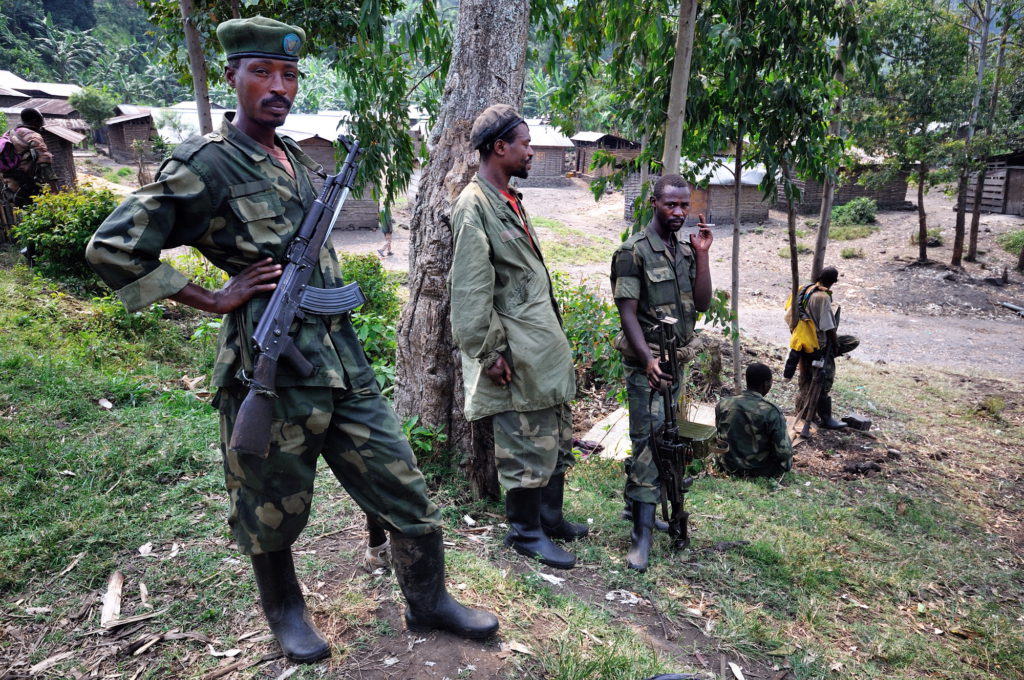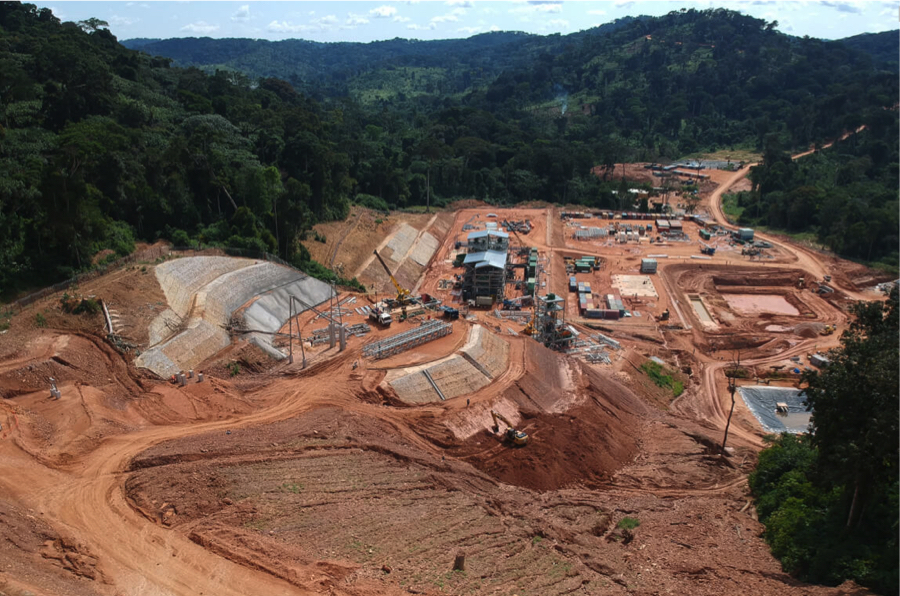Congo rebel gains to boost illicit mineral trade through Rwanda, analysts say
Reuters | January 28, 2025 |

M23 troops in Bunagana, Democratic Republic of the Congo. Credit: Wikimedia Commons
A lightning advance in Congo’s mineral-rich eastern borderlands is set to boost the M23 rebellion’s illegal mining revenues, with analysts predicting a further surge in illicit trade in minerals including coltan and gold through neighbouring Rwanda.

The Rwanda-backed insurgency entered Goma, eastern Democratic Republic of Congo’s largest city, this week, marking a major turning point in a conflict with government forces that has raised fears of a spillover into a broader regional war.
The rebels, which Rwanda denies supporting, have long been funded at least in part by the illicit mineral trade. Those revenue flows intensified after M23 – the latest in a long line of Tutsi-led rebellions – seized the coltan-rich Rubaya area in April, UN experts found.
Congo is the world’s top producer of tantalum and cobalt, a key component in batteries for electric vehicles and mobile phones, and is also home to significant coltan and gold deposits.
“Mineral exports from Rwanda are now over a billion dollars a year,” said Jason Stearns, a political scientist at Simon Fraser University and former UN investigator.
“That’s about double what they were two years ago. And we don’t know how much, but a fair chunk of that is from the DRC.”
Rwanda’s ambassador-at-large for the Great Lakes region Vincent Karega rejected the idea that M23 was trafficking Congolese minerals. He did not directly address allegations that his government is involved in their illicit trade.
“Do you think it’s possible to fight and still have time to mine natural resources and refine them?” said Karega, who has been sent to the border with Congo to oversee the crisis.
Lack of transparency
Rebels recently captured the mining town Lumbishi in South Kivu province. Numbi, an eastern mining area in South Kivu rich in gold, tourmaline, and tin, tantalum and tungsten – so-called 3T minerals used in computers and mobile phones – is also under threat.
“Lumbishi and its gold mines are likely to prove a significant source of revenue for M23, in part because gold is much easier to monetise than coltan and tin,” said Gregory Mthembu-Salter, director of Phuzumoya Consulting.
He said gold was likely to make its way to Dubai via Rwanda and possibly Kenya.
In 2023, UAE declared importing about $885 million in gold from Rwanda, a 75% jump from the previous five-year average, according to a Reuters analysis of UN Comtrade data. Rwanda is not a major gold producer.
In addition to exerting administrative control over Rubaya, M23 has also created a monopoly for the export of coltan to Rwanda from the nearby Bibatama mine, UN experts said in a December report. The mine is one of the world’s largest deposits of coltan, used in cellphones and laptops.
The group collected at least $800,000 per month in taxes on coltan production and trade, according to the report, with Congolese output mixed in with Rwandan production.
Jean Pierre Okenda, a Congo-based rights lawyer specialized in extractive industries, said Rwanda was not a member of any international transparency initiatives, making it hard to track its minerals.
“There is a lack of transparency of the mining operations and… a lack of transparency of the geological information,” he said.
(By Sonia Rolley, Felix Njini, David Lewis, Joe Bavier and Reade Levinson; Editing by Jan Harvey; Writing by Sofia Christensen)
Tin miner Alphamin slumps after rebels take Congolese city
Bloomberg News | January 27, 2025 |

Bisie tin mine. Image from Alphamin Resources.
Alphamin Resources Corp. shares fell the most in nine years after Rwanda-backed rebels overran the eastern Congolese city of Goma, the capital of North Kivu province where the company’s tin mines are located.

The stock sank by as much as a third earlier Monday, then pared losses to trade down 9.4% at 97 Canadian cents as of 12:27 p.m. in Toronto.
After a rapid advance, so-called M23 rebels are now patrolling Goma, a trading hub for the Democratic Republic of Congo’s mineral exports to neighboring Rwanda. It’s not, however, a transit point for Alphamin’s tin, which comes from mines about 120 miles west of the city and is sent northeast to Uganda.
Chief executive officer Maritz Smith declined to comment when emailed Monday.
Congo’s east has been wracked by conflict for three decades, a drag on investment in Alphamin, which is listed in both Toronto and Johannesburg. The company started output in the Central African country in 2019 and produced a record 17,324 tons of tin last year. It plans to ramp up to 20,000 tons — about 6% to 7% of global production.
(By Michael J. Kavanagh and William Clowes)
Read More: Abu Dhabi’s IRH explores investing in Alphamin’s Congo tin mines
Reuters | January 28, 2025 |

M23 troops in Bunagana, Democratic Republic of the Congo. Credit: Wikimedia Commons
A lightning advance in Congo’s mineral-rich eastern borderlands is set to boost the M23 rebellion’s illegal mining revenues, with analysts predicting a further surge in illicit trade in minerals including coltan and gold through neighbouring Rwanda.

The Rwanda-backed insurgency entered Goma, eastern Democratic Republic of Congo’s largest city, this week, marking a major turning point in a conflict with government forces that has raised fears of a spillover into a broader regional war.
The rebels, which Rwanda denies supporting, have long been funded at least in part by the illicit mineral trade. Those revenue flows intensified after M23 – the latest in a long line of Tutsi-led rebellions – seized the coltan-rich Rubaya area in April, UN experts found.
Congo is the world’s top producer of tantalum and cobalt, a key component in batteries for electric vehicles and mobile phones, and is also home to significant coltan and gold deposits.
“Mineral exports from Rwanda are now over a billion dollars a year,” said Jason Stearns, a political scientist at Simon Fraser University and former UN investigator.
“That’s about double what they were two years ago. And we don’t know how much, but a fair chunk of that is from the DRC.”
Rwanda’s ambassador-at-large for the Great Lakes region Vincent Karega rejected the idea that M23 was trafficking Congolese minerals. He did not directly address allegations that his government is involved in their illicit trade.
“Do you think it’s possible to fight and still have time to mine natural resources and refine them?” said Karega, who has been sent to the border with Congo to oversee the crisis.
Lack of transparency
Rebels recently captured the mining town Lumbishi in South Kivu province. Numbi, an eastern mining area in South Kivu rich in gold, tourmaline, and tin, tantalum and tungsten – so-called 3T minerals used in computers and mobile phones – is also under threat.
“Lumbishi and its gold mines are likely to prove a significant source of revenue for M23, in part because gold is much easier to monetise than coltan and tin,” said Gregory Mthembu-Salter, director of Phuzumoya Consulting.
He said gold was likely to make its way to Dubai via Rwanda and possibly Kenya.
In 2023, UAE declared importing about $885 million in gold from Rwanda, a 75% jump from the previous five-year average, according to a Reuters analysis of UN Comtrade data. Rwanda is not a major gold producer.
In addition to exerting administrative control over Rubaya, M23 has also created a monopoly for the export of coltan to Rwanda from the nearby Bibatama mine, UN experts said in a December report. The mine is one of the world’s largest deposits of coltan, used in cellphones and laptops.
The group collected at least $800,000 per month in taxes on coltan production and trade, according to the report, with Congolese output mixed in with Rwandan production.
Jean Pierre Okenda, a Congo-based rights lawyer specialized in extractive industries, said Rwanda was not a member of any international transparency initiatives, making it hard to track its minerals.
“There is a lack of transparency of the mining operations and… a lack of transparency of the geological information,” he said.
(By Sonia Rolley, Felix Njini, David Lewis, Joe Bavier and Reade Levinson; Editing by Jan Harvey; Writing by Sofia Christensen)
Tin miner Alphamin slumps after rebels take Congolese city
Bloomberg News | January 27, 2025 |

Bisie tin mine. Image from Alphamin Resources.
Alphamin Resources Corp. shares fell the most in nine years after Rwanda-backed rebels overran the eastern Congolese city of Goma, the capital of North Kivu province where the company’s tin mines are located.

The stock sank by as much as a third earlier Monday, then pared losses to trade down 9.4% at 97 Canadian cents as of 12:27 p.m. in Toronto.
After a rapid advance, so-called M23 rebels are now patrolling Goma, a trading hub for the Democratic Republic of Congo’s mineral exports to neighboring Rwanda. It’s not, however, a transit point for Alphamin’s tin, which comes from mines about 120 miles west of the city and is sent northeast to Uganda.
Chief executive officer Maritz Smith declined to comment when emailed Monday.
Congo’s east has been wracked by conflict for three decades, a drag on investment in Alphamin, which is listed in both Toronto and Johannesburg. The company started output in the Central African country in 2019 and produced a record 17,324 tons of tin last year. It plans to ramp up to 20,000 tons — about 6% to 7% of global production.
(By Michael J. Kavanagh and William Clowes)
Read More: Abu Dhabi’s IRH explores investing in Alphamin’s Congo tin mines
No comments:
Post a Comment